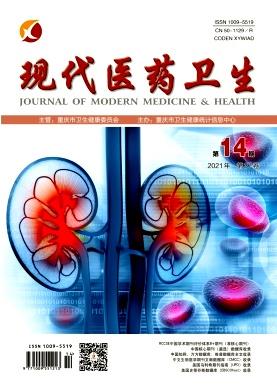Analysis of relationship between asthenopia and terminal screen exposure in college students during COVID-19 epidemic period.
引用次数: 0
Abstract
Objective To understand the relationship between the visual fatigue of college students and the exposure of terminal screens during the novel coronavirus pneumonia (New Coronary Pneumonia) epidemic. Methods The cluster sampling method of the current situation survey was adopted. From March 1 to July 1, 2020, a questionnaire survey of 2671 college students in Hefei City, Anhui Province was conducted to analyze the eye discomfort, daily eye use and eye care of college students during the new coronary pneumonia epidemic. Situation and so on. Results Among the 2 671 college students, 1 860 cases were positive for asthenopia, with a total positive rate of 69.64%. Eye fatigue [5646% (1508/2671)], dry eyes [46.01% (1 229/2 671)], eye swelling [ The incidence of 38.26% (1022/2671)], eye itching and pain [28.15% (752/2 671)] ranked the top 4. Lunch break habits and the number of drinking glasses per day are common protective factors for eye fatigue, dry eyes, sore eyes, and itchy eyes;closing doors and windows during online classes and staying up late each week are common risks for eye fatigue, dry eyes, and sore eyes Factors;daytime terminal screen exposure time is a common risk factor for dry eyes, sore eyes, and itchy eyes. Conclusion During the new crown pneumonia epidemic, the incidence of visual fatigue among college students is relatively high. Terminal screen exposure is one of the risk factors for visual fatigue. Reducing the exposure time of college students to terminal screens is an effective measure to prevent visual fatigue. (English) [ABSTRACT FROM AUTHOR] 目的了解新型冠状病毒肺炎(简称新冠肺炎)疫情期间大学生视疲劳与终端屏幕暴露的关 联。方法采用现况调查整群抽样方法,2020 年3月1日至7月1日通过问卷调查安徽省合肥市高校的2671 名大学生,分析新冠肺炎疫情期间大学生眼部不适、日常用眼及护眼情况等。结果 2 671 名大学生中视疲劳 阳性 1 860 例,总阳性率为69.64%,眼疲劳感[5646%(1508/2671)]、眼干涩[46.01%(1 229/2 671)]、眼酸 胀[38.26%(1022/2671)]、眼痒痛[28.15%(752/2 671)]发生率排前4位。午休习惯和每天饮水杯数是眼疲 劳感、眼干涩、眼酸胀、眼痒痛的共同保护因素;上网课时关闭门窗和每周熬夜次数是眼疲劳感、眼干涩、眼酸胀 的共同危险因素;白天终端屏幕暴露时间是眼干涩、眼酸胀、眼痒痛的共同危险因素。结论 新冠肺炎疫情期 间大学生视疲劳发生率较高,终端屏幕暴露是视疲劳的危险因素之一,降低大学生对终端屏幕暴露时间是预防 視疲劳的有效措施. (Chinese) [ABSTRACT FROM AUTHOR] Copyright of Journal of Modern Medicine & Health is the property of Journal of Modern Medicine & Health and its content may not be copied or emailed to multiple sites or posted to a listserv without the copyright holder's express written permission. However, users may print, download, or email articles for individual use. This abstract may be abridged. No warranty is given about the accuracy of the copy. Users should refer to the original published version of the material for the full abstract. (Copyright applies to all Abstracts.)新冠肺炎流行期大学生视疲劳与终端屏幕暴露的关系分析
目的了解新型冠状病毒肺炎(New冠状病毒肺炎)流行期间大学生视疲劳与终端屏幕暴露的关系。方法采用现状调查的整群抽样方法。2020年3月1日至7月1日,对安徽省合肥市2671名大学生进行问卷调查,分析新型冠状病毒肺炎疫情期间大学生眼部不适、日常用眼及眼部护理情况。情况等等。结果2 671名大学生中,弱视检查阳性1 860例,总阳性率为69.64%。眼疲劳[5646%(1508/2671)]、眼干[46.01%(1 229/2 671)]、眼肿胀[发生率38.26%(1022/2671)]、眼痒和眼痛[28.15%(752/2 671)]居前4位。午休习惯和每天喝多少杯是眼疲劳、眼干、眼痛、眼痒的常见保护因素;在线上课时关门窗、每周熬夜是眼疲劳、眼干、眼痛的常见风险因素;白天终端屏幕暴露时间是眼干、眼痛、眼痒的常见风险因素。结论新冠肺炎疫情期间,大学生视疲劳发生率较高。终端屏幕暴露是视觉疲劳的危险因素之一。减少大学生对终端屏幕的接触时间是预防视觉疲劳的有效措施。从作者(英文)[摘要]目的了解新型冠状病毒肺炎(简称新冠肺炎)疫情期间大学生视疲劳与终端屏幕暴露的关联。方法采用现况调查整群抽样方法,2020 年3月1日至7月1日通过问卷调查安徽省合肥市高校的2671 名大学生,分析新冠肺炎疫情期间大学生眼部不适、日常用眼及护眼情况等。结果2 671名大学生中视疲劳阳性1 860例,总阳性率为69.64%,眼疲劳感[5646%(1508/2671)],眼干涩[46.01%(1 229/2 671)],眼酸胀[38.26%(1022/2671)],眼痒痛[28.15%(752/2 671)]发生率排前4位。午休习惯和每天饮水杯数是眼疲 劳感、眼干涩、眼酸胀、眼痒痛的共同保护因素;上网课时关闭门窗和每周熬夜次数是眼疲劳感、眼干涩、眼酸胀 的共同危险因素;白天终端屏幕暴露时间是眼干涩、眼酸胀、眼痒痛的共同危险因素。结论 新冠肺炎疫情期 间大学生视疲劳发生率较高,终端屏幕暴露是视疲劳的危险因素之一,降低大学生对终端屏幕暴露时间是预防 視疲劳的有效措施. 【摘要】《现代医学与健康杂志》版权归《现代医学与健康杂志》所有,未经版权所有人书面许可,其内容不得被复制、通过电子邮件发送到多个网站或发布到某个列表服务器。但是,用户可以打印、下载或通过电子邮件发送文章供个人使用。这篇摘要可以删节。对副本的准确性不作任何保证。用户应参考资料的原始出版版本以获取完整摘要。(版权适用于所有摘要。)
本文章由计算机程序翻译,如有差异,请以英文原文为准。
求助全文
约1分钟内获得全文
求助全文

 求助内容:
求助内容: 应助结果提醒方式:
应助结果提醒方式:


